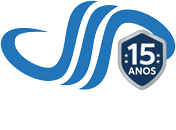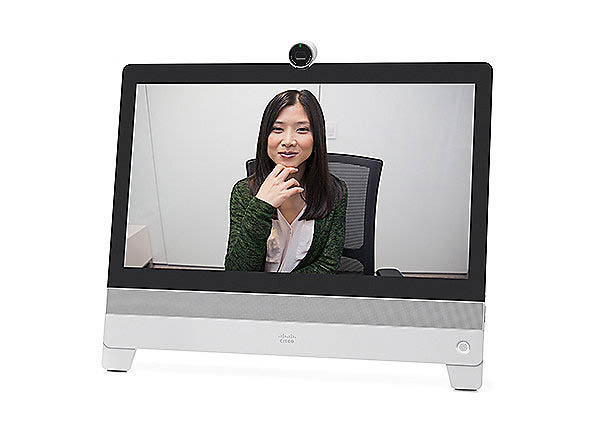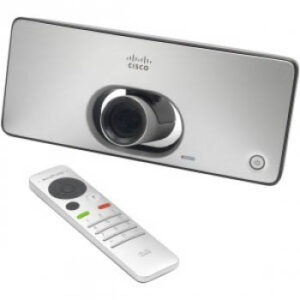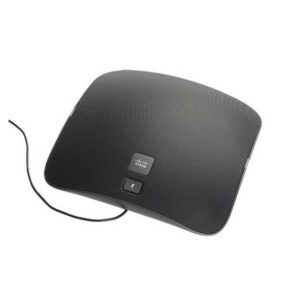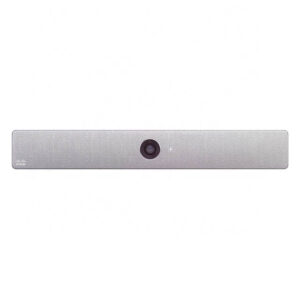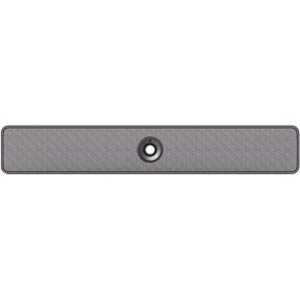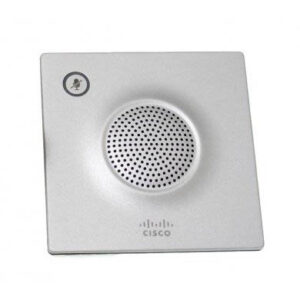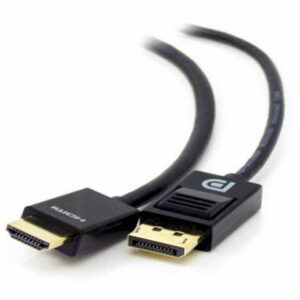Descrição
Cisco DX80 VoIP/SIP Touchscreen Desktop Video Communication System (23-inch) (CP-DX80-K9=)
Features
Components
- Fully integrated unit including:
- Codec
- Camera
- Display
- Microphones and loudspeaker
- HDMI and USB 2 meter long cable
- Ethernet 2,9 meters long cable
- Power adapter
Display
- 23-inch (0.58m) LCD monitor
- Resolution: 1920 x 1080 (16:9)
- High contrast IPS LED panel
- Contrast ratio: 1000:1 (typ.)
- Viewing angle: +/-178 deg (typ.)
- Response time: 5ms (typ.)
- Brightness: 215 cd/m2 (typ.)
- Colour depth: 16.7 million colours
- Colour gamut 72% (of NTSC)
- 10 point multi-touch surface
Supported PC input resolutions
- Up to 1080p
Ergonomic design
- The stand is retractable in the upright position for easy transportation
- The screen can be tilted from an angle of 11° to 50° from the vertical
- Camera can be tilted from an angle of -5° to 70° from the display
- The connector lid can be fully lifted and will lock to the back of the unit with magnets
Audio
- Loudspeaker mounted on the front panel and user facing
- 4 digital microphones mounted in 2 arrays
Front camera
- 63 degrees horizontal field of view
- 38 degrees vertical field of view
- Resolution: 1080p30
- F 2.2
- Instant Focus based on face detection
- Privacy shutter
Operating system
- Android OS 4.1.1 (Jellybean)
Processor
- TI OMAP 4470 1.5GHz dual-core ARM Cortex-A9 processor
Storage
- 8-GB eMMC NAND Flash memory (embedded multimedia card; nonvolatile)
Memory
- 2-GB RAM; Low Power Double Data Rate Synchronous Dynamic Random-Access Memory (LPDDR2 SDRAM)
Ports and slots
- High-Definition Multimedia Interface (HDMI) type A port for PC or Mac video input
- High-Definition Multimedia Interface (HDMI) type A port output (reserved for future use)
- High-speed USB 2.0 ports:
- Three standard type A ports (for keyboard, mouse, thumb drive and memory stick, and headset connectivity)
- One standard type B port (reserved for future use)
- One Micro-B USB port with native RS232, serial port, intended for service only
- Maximum of 500 mA power output at 5V or 2.5W for each USB port
- MicroSecure Digital Standard Capacity (HDSC) slot for nonvolatile storage of applications or file expansion up to 32GB (standard-definition [SD] card speed Class 4 or later recommended)
Physical buttons
- Capsense “source” button to swap between HDMI input and the DX80 interface. Button is lit when HDMI input is connected.
- Volume up/down
- Mute
Visual indicator
- CameraLED indicator (incoming calls, camera activation)
- Microphone LED indicator (mute)
- Power button LED indicator (power on, sleeping, message waiting, error)
- Source button (monitor mode)
Physical dimensions (HxWxD)
- 20,2 x 22,2 x 3,5 in. (51.2 x 56. 5 x 8.9 cm)
Weight
- 15,65 lb (7.1 kg)
Power
- Rated: 60 W maximum
- Low Power Standby mode
- Integrated EnergyWise support
Physical security
- Compatible with Kensington Security Slot
Connectivity
Ethernet
- Internal 2-port Cisco Ethernet switch allows for a direct connection to a 10/100/1000BASE-T Ethernet network (IEEE802.3i/802.3u/802.3ab) through an RJ-45 interface with single LAN connectivity for both the phone and a co-located PC.
- The system administrator can designate separate VLANs (IEEE 802.1Q) for the PC and phone, providing improved security and reliability of voice and data traffic.
Desktop WiFi
- As an alternative to wired Ethernet, the DX80 supports a Wi-Fi radio with integrated antenna enabling connectivity to a Wi-Fi access-point infrastructure, thereby saving on the labor costs of pulling Ethernet cables to every work location.
Network features
- CiscoDiscovery Protocol
- Cisco Peer-to-Peer Distribution Protocol (PPDP)
- LLDP-MED
- Session Initiation Protocol (SIP) for signaling
- Session Description Protocol (SDP)
- User Datagram Protocol (UDP) (used only for Real-Time Transport Protocol [RTP] streams)
- Dynamic Host Configuration Protocol (DHCP) client or static configuration
- Transparent secure roaming
- Gratuitous Address Resolution Protocol (GARP)
- Switch auto-negotiation
- Domain Name System (DNS)
- Web proxy (configured manually or by auto-configuration Protected Access Credential [PAC] files)
- NT LAN Manager (NTLM) and Kerberos authentication
- Trivial File Transfer Protocol (TFTP)
- Secure Hypertext Transfer Protocol (HTTPS)
- WiFi management
- IPv4 configuration
- IPv6 configuration
- Virtual Local Area Network (VLAN)
- Real-Time Control Protocol (RTCP) (provides quality of service [QoS] data [such as jitter, latency, and round-trip delay]
- on RTP streams in order to provide a better video experience)
- Secure Real-Time Transport Protocol (SRTP)
- Software port speed (manual or auto-configuration, including disablement)
- PC port speed (manual or auto-configuration, including disablement)
Bluetooth
- Bluetooth 3.0 Enhanced Data Rate (EDR) Class 2 technology (up to 30-ft [10m] range)
- HumanInterface Device (HID) keyboard and mouse support for adding additional input accessories
- Hands-Free Profile (HFP) for untethered headset connections and voice communications
- Phone Book Access Profile (PBAP), which enables the exchange of phone book objects between devices
- Advanced Audio Distribution Profile (A2DP) for streaming audio
- Object Push Profile (OPP) for generic file exchange
Accessories
- Cisco VESA adapter and wall mount
- The DX80 supports a 100×100 mm VESA mounting. This option includes the VESA adapter as well as a fixed and flat wall mount holder.
Firmware
Version
- 10.2.1 firmware
Call platform support; provisioning and management
- Minimum supported: Cisco UCM Version 8.5(1), 8.6(1), 8.6(2)
- Recommended: Cisco UCM Version 9.1(2), 10.5(1) and later
- Minimum supported Cisco UCM for Cisco Expressway: 9.1(2) SU1
- Minimum Supported Cisco Expressway X8.5.x
- Cisco Hosted Collaboration Solution (HCS)
- Cisco Business Edition 6000 Version 9.1 or later
Upgrading process
- Software upgrade of the device through Cisco UCM
- Support for online firmware upgrades using TFTP
- HTTP firmware management
Temperature range
Operating temperature
- 32 to 104F (0 to 40C)
Relative humidity
- 10 to 90% (non condensing)
Storage temperature
- -4 to 140F (-20 to +60C)
Approvals and compliance
- Directive2006/95/EC (Low-Voltage Directive) – Standard EN 60950-1
- Directive 2004/108/EC (EMC Directive) – Standard EN 55022, Class B – Standard EN 55024 – Standard EN 61000-3-2/-3-3
- Compliance with ETSI EN 301 489, ETSI EN 300 328, ETSI EN 301 893
- Directive 2011/65/EU (RoHS), Directive 2009/125/EC (ErP), Directive 2002/96/EC (WEEE)
- Approved according to UL 60950-1 and CNA/CSA C22.2 No. 60950-1-07
- Compliance with FCC CFR 47 Part 15 Class B
- Compliance with CFR 47 Part 15.247, CFR 47 Part 15.407, 47 CFR Part 2.1093 FCC Applicable KDB’s
Video and Audio Specifications
Video standards
- H.264 and AVC (H.264/MPEG-4 Part 10 Advanced Video Coding)
Minimum bandwidth for resolution and frame rate (30 fps)
- CIF 352 x 288 (4:3) 64-299 kbps
- VGA 640 x 480 (4:3) 400-1500 kbps
- 360p (640 x 360) 300-599 kbps
- 480p (848 x 480) 600-799 kbps
- 576p (1024 x 576) 800-1299 kbps
- 600p (1024 x 600) 800-3000 kbps
- 720p (1280 x 720) 1300-1999 kbps
- 1080p (1920 x 1080) 2000-4000 kbps
Frame or picture format
- CIF (352 x 288 pixels)
- VGA (640 x 480 pixels)
- 240p (432 x 240 pixels)
- 360p (640 x 360 pixels)
- 480p (848 x 480 pixels)
- WSVGA (1024 x 600 pixels)
- HD 720p (1280 x 720 pixels)
- HD1080p (1920 x 1080 pixels)
Video features
- On-screen layout control for video and presentation.
- Selfview
Supported HDMI input resolutions
- Supports formats up to maximum 1920 x 1080 @ 60 fps (HD1080p60), including:
- 640 x 480 @ 60 fps
- 1280 x 720 @ 60 fps
- 1920 x 1080 @30 fps
- 1920 x 1080 @60 fps
- High-definition inputs use progressive video formats
Audio standards
- Narrowband audio compression codecs: G.711a, G.711u, G.729a, G.729ab, and Internet Low Bitrate Codec (iLBC)
- Wideband and full-band audio compression codecs: G.722, Internet Speech Audio Codec (iSAC), and AAC-LD (MP4A-LATM) audio compression codecs.
Audio features
- Loudspeaker frequency range: 70Hz – 20kHz
- Microphones frequency range: 100z – 20kHz
- Up to 48kHz sampling rate
- Automatic static noise reduction
- Configurable directive microphone
- Acoustic echo cancellers
- Automatic Gain Control (AGC)
- Active lip synchronisation
Dual stream
- Binary Floor Control Protocol (BFCP) (SIP) dual stream
- Supports resolutions up to 1080p (1920 x 1080)
Software Features
Android core features
- Fullycustomisable Cisco Launcher and App Tray “Home Screen” enables you to place your own application shortcuts, widgets, and folders
- Home screen supports up to five separate screen views or pages with a 12 x 9 icon grid
- Landscape-orientated applications are supported
- On-screen keyboard is supported
Android bundled applications and widgets
- Calculator
- Calendar
- Camera
- Clock
- Contacts
- Direct Dial
- Internet Message Access Protocol (IMAP)
- Post Office Protocol 3 (POP3)
- Microsoft Exchange ActiveSync
- Favorites
- Gallery
- Phone features (for example, Forward All, Privacy, Do Not Disturb, Mobility, and Self-View)
- Wallpapers (including Live Wallpapers)
- Web browser
Google bundled applications
- Google Play (enabled by administrator through Cisco UCM; includes country-approved Google mobile services applications)
- Gmail
- Google settings
- Maps
- Play Books
- Play Magazines
- Play Movies
- Play Music
- Google Now
Cisco bundled applications
- Cisco AnyConnect® Secure Mobility Client (VPN)
- Cisco Jabber IM (which offers chat and presence capabilities)
- Cisco WebEx
- Quick Contact Badge (allows you to easily collaborate with your contacts to place a call, send an email message, send an instant message (IM), or start a WebEx® meeting)
- Visual Voicemail
Intelligent Proximity for Mobile Voice
- Contact synchronisation with Bluetooth-paired, Android or iOS mobile device that supports PBAP
- Call history synchronisation to view placed or missed calls from mobile device on the DX80
- Audio path routing sends audio through the DX80 for a mobile device-connected call
Configuration modes
- Enhanced, fully-functional mode that enables all aspects of the phone including applications and accounts
- Simple mode that hides applications, accounts and provides only voice and video call capabilities
- Public mode based on Simple mode with restrictions on user settings modifications.
Application deployment options and management
- The administrator can disable any and all applications from being downloaded on the Cisco DX650/70/80. Specifically, the administrator can configure the DX650/70/80 to prohibit the installation of any third-party Android applications.
- Google Play access can be administratively disabled (default). Applications from “unknown sources” can be administratively disabled (default):
- The administrator can optionally install applications using Cisco Unified Communications Manager with the APK file.
- Company Photo Directory (ability to set up and link photo directory URL image location associated with respective user)
- Company Photo Directory (ability to set up and link photo directory URL image location associated with respective user).
Built-in training and setup assistance
- Setup Assistant wizard (helps configure email, Jabber IM, WebEx, and Voice Mail account settings)
Third party application development
- Cisco Collaboration application programming interfaces (APIs) through a Software Developer Kit (SDK) https://developer.cisco.com/site/dxseries/overview/index.gsp
Language support
- Arabic, Egypt (ar_EG)
- Bulgarian, Bulgaria (bg_BG)
- Catalan, Spain (ca_ES)
- Chinese, PRC (zh_CN)
- Chinese, Taiwan (zh_TW)
- Croatian, Croatia (hr_HR)
- Czech, Czech Republic (cs_CZ)
- Danish, Denmark (da_DK)
- Dutch, Netherlands (nl_NL)
- English, Britain (en_GB)
- English, United States (en_US)
- Finnish, Finland (fi_FI)
- French, France (fr_FR)
- German, Germany (de_DE)
- Greek, Greece (el_GR)
- Hebrew, Israel (he_IL)
- Hungarian, Hungary (hu_HU)
- Italian, Italy (it_IT)
- Japanese (ja_JP)
- Korean (ko_KR)
- Latvian, Latvia (lv_LV)
- Lithuanian, Lithuania (lt_LT)
- Norwegian bokmål, Norway (nb_NO)
- Polish (pl_PL)
- Portuguese, Brazil (pt_BR)
- Portuguese, Portugal (pt_PT)
- Romanian, Romania (ro_RO)
- Russian (ru_RU)
- Serbian, Republic of Serbia (sr_RS)
- Slovak, Slovakia (sk_SK)
- Slovenian, Slovenia (sl_SI)
- Spanish, Spain (es_ES)
- Swedish, Sweden (sv_SE)
- Thai, Thailand (th_TH)
- Turkish, Turkey (tr_TR)
Calling feature support
- + Dialing (ITU E.164)
- Abbreviated dialing
- Adjustable ringing and volume levels
- Adjustable display brightness
- Auto-answer
- Auto-detection of headset
- Barge (cBarge)
- Callback
- Call Chaperone
- Call forward
- Call forward notification
- Call history lists
- Call park (including Directed Call Park and Assisted Directed Call Park)
- Call pickup
- Call timer
- Call waiting
- Caller ID
- Corporate directory
- Conference (ad hoc)
- Direct transfer
- Divert (iDivert)
- Do Not Disturb (DND)
- Extension Mobility service
- Fast-dial service
- Forced access codes and client matter codes
- Group call pickup
- Hold (and Resume)
- Intercom
- International call logging
- Join (ad hoc)
- Last-number redial (LNR)
- Malicious-caller ID
- Message-waiting indicator (MWI)
- Meet-me conference
- Mobility (Mobile Connect and Mobile Voice Access)
- Music on hold (MoH)
- Mute (audio and video)
- Network profiles (automatic)
- On- and off-network distinctive ringing
- Personal directory
- PickUp
- Predialing before sending
- Privacy
- Private Line Automated Ringdown (PLAR)
- Ring tone per line appearance
- Self-View (video call)
- Service URL
- Shared line(s)
- Silent Monitoring and Recording
- Time and date display
- Transfer (ad hoc)
- Visual Voicemail
- Voicemail
Emergency services
- Emergency Calling Service dialing
Accessibility features
- Additional accessibility features for the vision impaired, blind, and the hearing and mobility impaired include user-defined and customisable:
- Displayfont size and screen brightness settings
- Touchscreen customisable touch and hold delay
- Talkback audio prompts and spoken password
- Support for Explore by Touch features
Security features
Hardware (Sat)
- Secure boot
- Secure credential storage
- Device authentication
- File authentication and encryption
- Image authentication and encryption
- Signaling authentication
- Random bit generation
- Hardware cryptographic acceleration
- Encrypted configuration files
- Encrypted file system
Certificate management
- Certificate Authority Proxy Function (CAPF) support for additional security
- Manufacturer-Installed Certificates (MIC)
- Locally Significant Certificates (LSC)
- X.509 Digital Certificates (DER encoded binary); both DER and Base-64 formats are acceptable for the client and server certificates; certificates with a key size of 1024, 2048, and 4096 are supported
Network
- Wired: 802.1x supplicant options for network authentication use:
- Extensible Authentication Protocol: Extensible Authentication Protocol-Flexible Authentication via Secure Tunneling
- (EAP-FAST)
- Extensible Authentication Protocol: EAP Transport Layer Security (EAP-TLS)
- Wireless:
- (refer to Table 5)
- Wireless: Wi-Fi Protected Access 2 (WPA2) (EAP-FAST)
- Wireless Equivalent Privacy (WEP)
- EAP-TLS
- Protected Extensible Authentication Protocol – Generic Token Card (PEAP-GTC)
Media and data signalling
- TLS
- SRTP
- HTTPS for clients
Enterprise access
- Cisco AnyConnect Secure Mobility Client
- Web Proxy (manual configuration or auto-configuration of Protected
- Access Credential [PAC] files)
- NTLM and Kerberos authentication
Device management
- Remote wipe
- ActiveSync remote wipe (email, contacts, calendar, etc.)
- Self-service wipe
- Wipe after unsuccessful login attempts
- Factory reset
Policy management
- Password complexity
- Disable USB
- Disable Speakerphone
- Disable Headset
- Secure Digital I/O (SDIO) enable/disable
- Bluetooth
- WiFi
- Access to Android market
- Screen Lock and Automatic Lock (PIN or password) device
- Android Debug Bridge (ADB)
Diagnostics
- The integrated Cisco Collaboration Problem Report Tool can send information directly to your system administrator when you experience problems with your phone or application (requires a configured email account)
WiFi Features and Specifications
Protocol
- IEEE 802.11a, 802.11b, 802.11g, and 802.11n
Frequency band and operating channels
- 2.412 – 2.472 GHz (channels 1 – 13)
- 5.180 – 5.240 GHz (channels 36 – 48)
- 5.260 – 5.320 GHz (channels 52 – 64)
- 5.500 – 5.700 GHz (channels 100 – 140)
- 5.745 – 5.825 GHz (channels 149 – 165)
- IEEE 802.11d is used to identify available channels
Non overlapping channels
- 2.4 GHz (20 MHz channels): up to 3 channels
- 5 GHz (20 MHz channels): up to 24 channels
- 5 GHz (40 MHz channels): up to 9 channels
Operating modes
- Auto (default), preference to strongest RSSI for 2.4 GHz or 5 GHz
- 2.4 GHz only
- 5 GHzonly
Data rates
- 802.11a: 6, 9, 12, 18, 24, 36, 48, 54 Mbps
- 802.11b: 1, 2, 5.5, 11 Mbps
- 802.11g: 6, 9, 12, 18, 24, 36, 48, 54 Mbps
- 802.11n: HT MCS 0, MCS 1, MCS 2, MCS 3, MCS 4, MCS 5, MCS 6, MCS 7
2.4GHz receiver sensitivity
IEEE 802.11b:
- 1 Mbps: -95 dBm
- 2 Mbps: -93 dBm
- 5.5 Mbps: -90 dBm
- 11 Mbps: -86 dBm
IEEE 802.11g:
- 6 Mbps: -89 dBm
- 9 Mbps: -89 dBm
- 12 Mbps: -87 dBm
- 18 Mbps: -85 dBm
- 24 Mbps: -81 dBm
- 36 Mbps: -78 dBm
- 48 Mbps: -74 dBm
- 54 Mbps: -72 dBm
IEEE 802.11n HT20:
- MCS 0: -88 dBm
- MCS 1: -86 dBm
- MCS 2: -84 dBm
- MCS 3: -81 dBm
- MCS 4: -78 dBm
- MCS 5: -73 dBm
- MCS 6: -71 dBm
- MCS 7: -69 dBm
5GHz receiver sensitivity
IEEE 802.11a:
- 6 Mbps: -91 dBm
- 9 Mbps: -91 dBm
- 12 Mbps: -90 dBm
- 18 Mbps: -88 dBm
- 24 Mbps: -85 dBm
- 36 Mbps: -81 dBm
- 48 Mbps: -77 dBm
- 54 Mbps: -76 dBm
IEEE 802.11n HT20:
- MCS 0: -91 dBm
- MCS 1: -89 dBm
- MCS 2: -86 dBm
- MCS 3: -84 dBm
- MCS 4: -81 dBm
- MCS 5: -76 dBm
- MCS 6: -74 dBm
- MCS 7: -72 dBm
IEEE 802.11n HT40:
- MCS 0: -90 dBm
- MCS 1: -87 dBm
- MCS 2: -85 dBm
- MCS 3: -81 dBm
- MCS 4: -78 dBm
- MCS 5: -74 dBm
- MCS 6: -72 dBm
- MCS 7: -70 dBm
Transmitter output power
2.4 GHz:
- 802.11b: up to 16 dBm
- 802.11g: up to 16 dBm
- 802.11n HT20: up to 15 dBm
5 GHz:
- 802.11a: up to 16 dBm
- 802.11n HT20: up to 15 dBm
- 802.11n HT40: up to 15 dBm
Antenna
- 2.4 GHz: 4.6 dBi peak gain
- 5 GHz: 7.0 dBi peak gain
Access point support
- Cisco Unified Access Points
- Minimum: 7.0.240.0
- Recommended: 7.4.121.0, 7.6.110.0 or later
- Cisco Autonomous Access Points
- Minimum: 12.4(21a)JY
- Recommended: 12.4(25d)JA2 or later
Wireless security
- Authentication:
- Wi-FiProtected Access (WPA) Versions 1 and 2 Personal and Enterprise
- Extensible Authentication Protocol – Flexible Authentication via Secure Tunneling (EAP-FAST)
- Protected Extensible Authentication Protocol – Microsoft Challenge Handshake Authentication Protocol Version 2 (PEAP-MSCHAPv2)
- Protected Extensible Authentication Protocol – Generic Token Card (PEAP-GTC)
- Extensible Authentication Protocol – Transport Layer Security (EAP-TLS)
- Encryption:
- 40-bit and 128-bit static Wired Equivalent Privacy (WEP)
- Temporal Key Integrity Protocol (TKIP) and Message Integrity Check (MIC)
- Advanced Encryption Standard (AES)
Fast secure roaming
- Cisco Centralised Key Management (CCKM)
QoS
- IEEE802.11e and Wi-Fi Multimedia (WMM)
- Enhanced Distributed Channel Access (EDCA)
- QoS Basic Service Set (QBSS)
Radar detection
- Dynamic frequency selection (DFS) and transmit power control (TPC) according to IEEE 802.11h
Warranty
- 1-year limited

